|
My regular wine/dinner group, the
X-pensive Winos, managed to collect 21
examples of Bob Foley’s craft, including all of the estates he has made
wine for, more than enough to give a good comprehensive survey of the
man’s talents. The wines were served with a seven course meal, but
frankly with wines like these, the food, as good as it was, became
secondary.
First Flight: The Lonely White Wine:
While not at all known for making whites, Foley is releasing his first
white under his own label, the 2007 Foley Estate Pinot Blanc. The
wine is all crisp pippin apples and pit fruits. Crisp acids support the
fruit, and some spiciness give the impression of a bit of Gewurztraminer
in the mix (there is none). Fresh, taut and with good length that
flattens out just a bit on the finish. Very nice, clean white with some
complexity. Find this wine
Second Flight: The Merlot’s: Foley
makes, big, rich, muscular Merlots that drink more like Cabernets to my
taste. The 1996 Paloma Merlot Find
Paloma Merlots had a rather shy but nice nose of
ripe berry fruit and a touch of minerality, but the palate was a bit
thin and the fruit had clearly faded to some extent, making the tannic
structure of the wine too apparent. Since the loss of primary fruit
intensity wasn’t accompanied by an increase in complexity, this wine
seemed clearly past its best, but it was probably a very nice wine 2-3
years ago. Not at all close to fading is the 2001 Paloma Merlot,
the wine that shot the Paloma name to fame when The Wine Spectator named
it their “Wine of the Year” in 2003. Bigger and richer than the 1996,
the wine is exceptionally rich for a Merlot with dense, ripe but not
overripe fruit, plums and blackberries with a hint of chocolate,
tremendous length and persistence on the palate. The structure is firm
but unobtrusive, and promises a good evolution for at least a few more
years. Even better to me was the 2001 Pride Mountaintop Merlot,
from a vineyard that is just on the
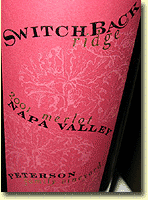 Sonoma
side of the Napa/Sonoma County line up on Spring Mountain. Even richer
than the Paloma, but with good structure and focus, and no hint of
pruney or overripe flavors. Darker chocolate covered cherries and
blackberries lead to a long, complex finish. A fabulous merlot in a ripe
style. The 2001 Switchback Ridge Find this wine took ripeness even further, and
perhaps a bit too far for my palate, although this appeared to be the
group’s overall favorite of the flight. This wine had a very dense,
liqueur-like texture and fruit flavors that were close to raisiny,
showing a bit of heat and some bitter tannins on the finish. Most of the
group, however, loved the richness and intensity of the wine, and
although I found it a bit over-the-top, it was only just, and is still a
very impressive wine. Finally, the 2005 Foley Merlot Find this wine is the first
varietal Merlot under Bob Foley’s estate label. Whether the result of
the vintage or the style Foley is going for in his estate wines, this
wine seemed more elegant, and not as extracted as the preceding wines.
Still plenty of fruit, with an interesting pit-fruit note that reminded
me of a Cote Rôtie that has a little viognier in it. Well structured
with plenty of tannins that give the finish a hint of bitterness, this
is a wonderfully complex wine that seems to have the potential for
development in bottle. WOTF: 2001 Pride Mountaintop Merlot. Find this wine Sonoma
side of the Napa/Sonoma County line up on Spring Mountain. Even richer
than the Paloma, but with good structure and focus, and no hint of
pruney or overripe flavors. Darker chocolate covered cherries and
blackberries lead to a long, complex finish. A fabulous merlot in a ripe
style. The 2001 Switchback Ridge Find this wine took ripeness even further, and
perhaps a bit too far for my palate, although this appeared to be the
group’s overall favorite of the flight. This wine had a very dense,
liqueur-like texture and fruit flavors that were close to raisiny,
showing a bit of heat and some bitter tannins on the finish. Most of the
group, however, loved the richness and intensity of the wine, and
although I found it a bit over-the-top, it was only just, and is still a
very impressive wine. Finally, the 2005 Foley Merlot Find this wine is the first
varietal Merlot under Bob Foley’s estate label. Whether the result of
the vintage or the style Foley is going for in his estate wines, this
wine seemed more elegant, and not as extracted as the preceding wines.
Still plenty of fruit, with an interesting pit-fruit note that reminded
me of a Cote Rôtie that has a little viognier in it. Well structured
with plenty of tannins that give the finish a hint of bitterness, this
is a wonderfully complex wine that seems to have the potential for
development in bottle. WOTF: 2001 Pride Mountaintop Merlot. Find this wine
Third Flight: Making Pride’s Reputation:
This short flight consisted of the two wines that really made Pride
Mountain’s reputation as a top producer of rich, ripe-style cabernets.
Interestingly, the two wines couldn’t have been more different, even
though Foley stated that the wines were virtually identical in terms of
the fruit, wine-making, etc. The 1995 Pride Reserve Cabernet was
rich, very complex, with tremendous depth of perfectly ripe fruit.
Well-integrated oak accents the deep berry/cherry and cassis fruit,
leading to a long finish that is very slightly hot. This has the
complexity of a more classically-styled cabernet, with the richness and
intensity of a modern, ripe-fruit styled wine. The 1996 Pride Reserve
Cabernet, on the other hand, was for me way too ripe and raisiny,
with a hint of volatility poking out. More like a dry port, the fruit is
very, very ripe and dense and there is noticeable heat in the wine and
finish that is too intrusive to my palate. As I am perhaps more averse
to raisiny flavors in cabernet than many others in our group, for me the
clear WOTF was the 1995 Pride Reserve Cabernet. Overall, however,
the group seemed about evenly divided between the two wines, with a
slight majority of the attendees loving the richness and intensity of
the 1996 over the more restrained, elegant style of the 1995. Find
Pride Reserve Cabernets
Fourth Flight: The 2001 Cabernets:
Without question this was the Flight of the Night, as all
of these were tremendous wines that balanced depth, richness, and good
structures in equal measure. Foley described the vintage as one of the
most exceptional in his winemaking career. The 2001 Pride Reserve
Claret Find this wine was perhaps the most elegant of the four wines, plenty ripe,
rich and dense, but with very good balance, a hint of chocolate (a
characteristic of many of the Foley wines, it seems), good length. Even
better was the 2001 Pride Reserve Cabernet, which shared some
elegance in its silky texture but with more richness and density, and
with better acid to support the bigger fruit structure. The wine
combines complexity, elegance, and power in equal measure, quite a feat.
The 2001 Foley Claret Find this wine featured fruit that was amazingly sweet and
pure (not residual sugar-sweet, but with an impression of sweetness from
ripe fruit combined with good acidity). Very round and well-balanced, a
classic ripe-style California cabernet, and very close to the Pride
Reserve in style and quality. Finally the 2001 Switchback Ridge
Cabernet Find this wine was probably the biggest and ripest of the group, a bit
hot, but the good balancing acidity and tannin providing structure.
Probably as ripe a wine without going over-the-top as I would want, and
very impressive, but seemingly less complex than the Pride or Foley.
WOTF: 2001 Pride Reserve Cabernet, Find this wine with the Foley Claret a very
close second. But really all of these wines were at the same high level
of quality for me.
Fifth Flight: Hourglass and More:
Foley has made the wines at Hourglass since its inception. The 2002
Hourglass Cabernet Find
Hourglass Cabernets was in a more classic style and not as ripe as
many 2002 Napa cabernets. Well structure with cassis/berry fruit and a
hint of mint (from eucalyptus trees adjacent to the vineyard), rich but
a bit less ripe than many of the preceding wines, I really liked the
style of this. At first the 2004 Hourglass Cabernet seemed much
more ripe, but as it aired it began to display many of the more classic
attributes of the 2001, including that hint of mint. Both chocolate and
vanilla are present (although not any overt oakiness), as is plenty of
sweet fruit and creamy richness. By comparison, the 2005 Foley Claret Find this wine
seemed to have a bit less energy and precision. Quite ripe, softer and
less structured, it has plenty of ripe cabernet character, but seems
more subdued and less interesting than the others at this point in its
evolution. The 2005 Switchback Ridge Cabernet, Find this wine on the other hand,
is a true monster, very ripe, deep, and intense. This is the only wine
in the tasting I had tasted before, and at that tasting (which was
blind) both I and many others thought it was a syrah from Sine Qua
Non. Massive fruit, blueberries and chocolate, incredibly rich,
although not as much true cabernet character as the others. Still, it’s
an impressive and amazingly delicious wine. WOTF: 2004 Hourglass
Cabernet. Find this wine
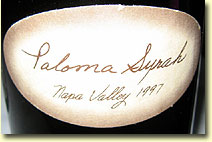 Sixth
Flight: Syrah, Petite Sirah, and Charbono: Sixth
Flight: Syrah, Petite Sirah, and Charbono:
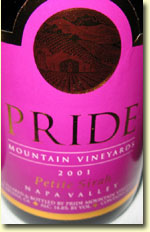 A
mixed bag here. I was very unimpressed with the 1997 Paloma Syrah,
Find this wine which seemed tired, oxidized, and devoid of syrah character. Maybe a
poorly stored bottle or a bad cork? Even Bob Foley had nothing good to
say about this bottle. I am not a big fan of petite sirah, so I wasn’t
surprised when the first wine, the 2001 Pride Petite Sirah
Find this wine seemed like no more than a tannic monster. Not really overripe, but very
big, extracted and intense, but with insufficient acid or fruit to
support the massive superstructure, and thus heavy and dull to my
palate. Much, much better was the 2001 Switchback Ridge Petite Sirah,
Find this wine which had all the bright acidity and sweet fruit that the Pride needed
but lacked. Equally large-scaled if not more so, the Switchback
nevertheless retained a semblance of balance to support the massive
fruit blast, and the fruit itself was ripe and sweet without becoming
raisiny or jammy. The 2004 Foley Petite Sirah Find this wine was almost as good,
with decent balance but perhaps just a bit too endowed with tannins,
which made themselves known mainly in the finish, giving a somewhat
over-extracted impression. Still, the fruit was delicious and intense.
Finally the 2006 Foley Charbono Find this wine was fascinating. From a little
known grape originally from France (but no longer made there) and rarely
made into a varietal here, the wine had good rich fruit, spicy, rather
softly structured but still decently balanced, with smooth dusty tannins
in a long finish. In comparison with more well-known varietals, its
character is perhaps most like a Grenache, and for me it was a more
interesting and enjoyable wine than most of the petites. WOTF, tie
between the 2001 Switchback Ridge Petite Sirah, and the Foley Charbono. A
mixed bag here. I was very unimpressed with the 1997 Paloma Syrah,
Find this wine which seemed tired, oxidized, and devoid of syrah character. Maybe a
poorly stored bottle or a bad cork? Even Bob Foley had nothing good to
say about this bottle. I am not a big fan of petite sirah, so I wasn’t
surprised when the first wine, the 2001 Pride Petite Sirah
Find this wine seemed like no more than a tannic monster. Not really overripe, but very
big, extracted and intense, but with insufficient acid or fruit to
support the massive superstructure, and thus heavy and dull to my
palate. Much, much better was the 2001 Switchback Ridge Petite Sirah,
Find this wine which had all the bright acidity and sweet fruit that the Pride needed
but lacked. Equally large-scaled if not more so, the Switchback
nevertheless retained a semblance of balance to support the massive
fruit blast, and the fruit itself was ripe and sweet without becoming
raisiny or jammy. The 2004 Foley Petite Sirah Find this wine was almost as good,
with decent balance but perhaps just a bit too endowed with tannins,
which made themselves known mainly in the finish, giving a somewhat
over-extracted impression. Still, the fruit was delicious and intense.
Finally the 2006 Foley Charbono Find this wine was fascinating. From a little
known grape originally from France (but no longer made there) and rarely
made into a varietal here, the wine had good rich fruit, spicy, rather
softly structured but still decently balanced, with smooth dusty tannins
in a long finish. In comparison with more well-known varietals, its
character is perhaps most like a Grenache, and for me it was a more
interesting and enjoyable wine than most of the petites. WOTF, tie
between the 2001 Switchback Ridge Petite Sirah, and the Foley Charbono.
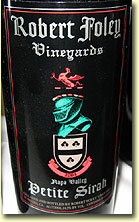 Overall,
this was a most impressive (and exhausting!) tasting. Foley clearly has
tremendous winemaking skills. What impressed me the most is that he can
craft extremely ripe, fruit-forward-styled wines from what must be very
ripe fruit, but without letting matters get out of hand by allowing
raisiny, pruney/jammy, or volatile flavors to mar the purity of the
fruit. Quite a few (not all) of the high-end “cult” cabernets I’ve
tasted are flawed to my palate by such overripe characteristics, and it
is a testament to Foley’s talents that he largely avoids these flaws
(which I acknowledge not everyone considers to be flaws). On the other
hand, there is a certain “sameness” to wines this ripe that pretty much
dilutes or eliminates regional characteristics based on terroir. To my
palate these are “Foley wines”, not “Spring Mountain” (for Pride) or
“St. Helena” (for Hourglass) wines. Nothing wrong with that, as long as
you’re not looking for a terroir-focused wine. If big, fruit-forward
wines that are rich but balanced is what you’re looking for, these wines
rank among the best of that style. Overall,
this was a most impressive (and exhausting!) tasting. Foley clearly has
tremendous winemaking skills. What impressed me the most is that he can
craft extremely ripe, fruit-forward-styled wines from what must be very
ripe fruit, but without letting matters get out of hand by allowing
raisiny, pruney/jammy, or volatile flavors to mar the purity of the
fruit. Quite a few (not all) of the high-end “cult” cabernets I’ve
tasted are flawed to my palate by such overripe characteristics, and it
is a testament to Foley’s talents that he largely avoids these flaws
(which I acknowledge not everyone considers to be flaws). On the other
hand, there is a certain “sameness” to wines this ripe that pretty much
dilutes or eliminates regional characteristics based on terroir. To my
palate these are “Foley wines”, not “Spring Mountain” (for Pride) or
“St. Helena” (for Hourglass) wines. Nothing wrong with that, as long as
you’re not looking for a terroir-focused wine. If big, fruit-forward
wines that are rich but balanced is what you’re looking for, these wines
rank among the best of that style.
Bennett Traub
Reporting From The Left Coast
Send Bennett an

|


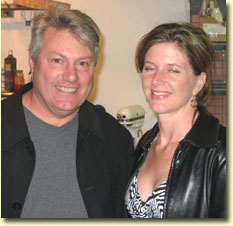 Among
Napa’s growing ranks of celebrated winemakers,
Robert Foley's star shines as brightly
as any. Beginning in the mid-90’s, few winemakers have his track record
for consistently crafting highly regarded (and high scoring) cabernets
and merlots in Napa. Among wine-lovers who follow such things, people
talk of “Foley wines” as much as, if not more so, than they invoke the
names of the estates for which Foley is the winemaker. Although I have
only limited experience with his wines (primarily from Pride
Mountain’s “regular” cabs and merlots), I recently had the
opportunity to taste a wide range of “Foley wines” with the man himself.
Joining Bob and his wife Kelly
(left) was
Kelly Peterson (below),
owner of one of his most celebrated clients, Switchback Ridge Winery.
Among
Napa’s growing ranks of celebrated winemakers,
Robert Foley's star shines as brightly
as any. Beginning in the mid-90’s, few winemakers have his track record
for consistently crafting highly regarded (and high scoring) cabernets
and merlots in Napa. Among wine-lovers who follow such things, people
talk of “Foley wines” as much as, if not more so, than they invoke the
names of the estates for which Foley is the winemaker. Although I have
only limited experience with his wines (primarily from Pride
Mountain’s “regular” cabs and merlots), I recently had the
opportunity to taste a wide range of “Foley wines” with the man himself.
Joining Bob and his wife Kelly
(left) was
Kelly Peterson (below),
owner of one of his most celebrated clients, Switchback Ridge Winery. Although
he seems to have burst onto the wine scene with Pride in the mid-90s,
Foley’s career goes back a good ways. Foley is a UC Davis graduate
(1977) with degrees in both enology and viticulture. His first job was
at Heitz, but a year later he moved on as the founding winemaker
at Markham Vineyards, a post he held for 15 years. He became the
winemaker at Pride on Spring Mountain in 1993 (as of January, 2008, he
is the consulting winemaker only), and since then he has also taken on
winemaking duties at Hourglass and Switchback Ridge. Hourglass is
located in the St. Helena AVA at the narrowest part of Napa Valley,
where it forms an hourglass shape. Switchback Ridge’s fruit comes from
the Peterson Family Vineyards, located across from the famous
Three Palms Vineyard in northeastern Napa Valley. For a time Foley
also made wines for Pride’s neighbor and former merlot supplier,
Paloma Vineyards. With all this he also found the time to embark on
his own wine estate, Robert Foley Vineyards (not to be confused
with Foley Estate in Santa Barbara’s Sta. Rita Hills—that Foley
is William Foley, no relation to Bob), beginning with the 1998 vintage.
Although
he seems to have burst onto the wine scene with Pride in the mid-90s,
Foley’s career goes back a good ways. Foley is a UC Davis graduate
(1977) with degrees in both enology and viticulture. His first job was
at Heitz, but a year later he moved on as the founding winemaker
at Markham Vineyards, a post he held for 15 years. He became the
winemaker at Pride on Spring Mountain in 1993 (as of January, 2008, he
is the consulting winemaker only), and since then he has also taken on
winemaking duties at Hourglass and Switchback Ridge. Hourglass is
located in the St. Helena AVA at the narrowest part of Napa Valley,
where it forms an hourglass shape. Switchback Ridge’s fruit comes from
the Peterson Family Vineyards, located across from the famous
Three Palms Vineyard in northeastern Napa Valley. For a time Foley
also made wines for Pride’s neighbor and former merlot supplier,
Paloma Vineyards. With all this he also found the time to embark on
his own wine estate, Robert Foley Vineyards (not to be confused
with Foley Estate in Santa Barbara’s Sta. Rita Hills—that Foley
is William Foley, no relation to Bob), beginning with the 1998 vintage.  Sonoma
side of the Napa/Sonoma County line up on Spring Mountain. Even richer
than the Paloma, but with good structure and focus, and no hint of
pruney or overripe flavors. Darker chocolate covered cherries and
blackberries lead to a long, complex finish. A fabulous merlot in a ripe
style. The 2001 Switchback Ridge
Sonoma
side of the Napa/Sonoma County line up on Spring Mountain. Even richer
than the Paloma, but with good structure and focus, and no hint of
pruney or overripe flavors. Darker chocolate covered cherries and
blackberries lead to a long, complex finish. A fabulous merlot in a ripe
style. The 2001 Switchback Ridge  Sixth
Flight: Syrah, Petite Sirah, and Charbono:
Sixth
Flight: Syrah, Petite Sirah, and Charbono:
 A
mixed bag here. I was very unimpressed with the 1997 Paloma Syrah,
A
mixed bag here. I was very unimpressed with the 1997 Paloma Syrah,
 Overall,
this was a most impressive (and exhausting!) tasting. Foley clearly has
tremendous winemaking skills. What impressed me the most is that he can
craft extremely ripe, fruit-forward-styled wines from what must be very
ripe fruit, but without letting matters get out of hand by allowing
raisiny, pruney/jammy, or volatile flavors to mar the purity of the
fruit. Quite a few (not all) of the high-end “cult” cabernets I’ve
tasted are flawed to my palate by such overripe characteristics, and it
is a testament to Foley’s talents that he largely avoids these flaws
(which I acknowledge not everyone considers to be flaws). On the other
hand, there is a certain “sameness” to wines this ripe that pretty much
dilutes or eliminates regional characteristics based on terroir. To my
palate these are “Foley wines”, not “Spring Mountain” (for Pride) or
“St. Helena” (for Hourglass) wines. Nothing wrong with that, as long as
you’re not looking for a terroir-focused wine. If big, fruit-forward
wines that are rich but balanced is what you’re looking for, these wines
rank among the best of that style.
Overall,
this was a most impressive (and exhausting!) tasting. Foley clearly has
tremendous winemaking skills. What impressed me the most is that he can
craft extremely ripe, fruit-forward-styled wines from what must be very
ripe fruit, but without letting matters get out of hand by allowing
raisiny, pruney/jammy, or volatile flavors to mar the purity of the
fruit. Quite a few (not all) of the high-end “cult” cabernets I’ve
tasted are flawed to my palate by such overripe characteristics, and it
is a testament to Foley’s talents that he largely avoids these flaws
(which I acknowledge not everyone considers to be flaws). On the other
hand, there is a certain “sameness” to wines this ripe that pretty much
dilutes or eliminates regional characteristics based on terroir. To my
palate these are “Foley wines”, not “Spring Mountain” (for Pride) or
“St. Helena” (for Hourglass) wines. Nothing wrong with that, as long as
you’re not looking for a terroir-focused wine. If big, fruit-forward
wines that are rich but balanced is what you’re looking for, these wines
rank among the best of that style.